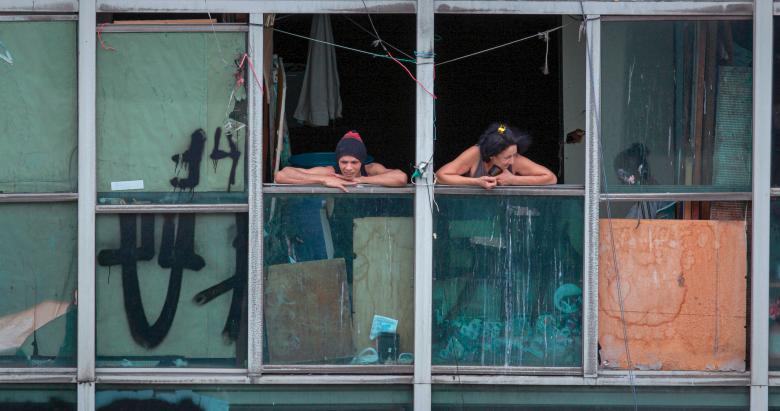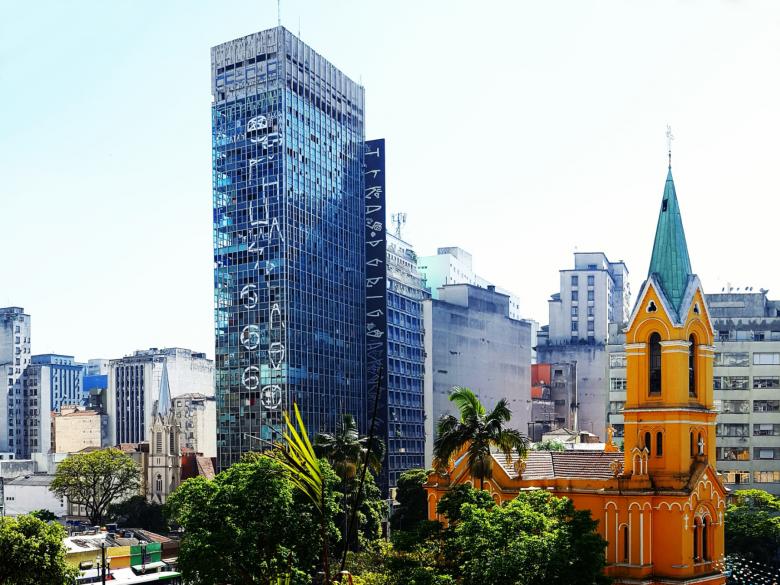Watching 'Skin of Glass'
Can a work of architecture reveal something about its creator? Or does a building only tell stories about its occupants? In Skin of Glass, filmmaker Denise Zmekhol attempts to learn more about her father, who died when she was just fourteen, by visiting his masterpiece, the 24-story “Pele de Vidro” (Skin of Glass) in São Paulo, an office building turned police station turned housing for squatters.
Zmekhol's journey in Skin of Glass begins by going back in time, to the early 1960s, when she was born and her father, Roger Zmekhol, was working on designs for “Pele de Vidro,” the affectionate name of the Wilton Paes de Almeida building in central São Paulo. “I was conceived the same time as the building,” she says early in the film, in a voiceover that alternates between Portuguese and English throughout the film. Such humor points to a good childhood, accentuated by family photos of Denise and her father having fun at the beach and the like. But how much does any child really know about a parent? A young child's impressions are filtered, naive. “He was everything a daughter could dream of: playful, charming, affectionate,” she says over a grinning photo of the pair, but then soon admits that “we never got a chance to talk about his early years.”
The information Zmekhol presents about her father's past is, initially at least, rudimentary: born in Paris from Syrian parents, he emigrated to Brazil, went to architecture school (FAU-USP), where he was hard-working and soon after graduation was a prolific architect. He met Denise's mother at the age of 29, they married, and “together began building dreams.” The archival images on the screen add layers to the little bits of information, especially a photo of Denise's parents on their wedding day holding a model of the house Roger designed for them and their family.
Perhaps owing to his death in 1976 at the age of 48, easily available information on Roger Zmekhol online is scarce; he does not have an entry on English Wikipedia, and the one devoted to him on Portuguese Wikipedia is short, with just one — severely incomplete — citation. Briefly setting aside what Skin of Glass might accomplish personally for its filmmaker, the film's greatest value might be stimulating enough interest in Roger Zmekhol to produce a full-fledged biography, in multiple languages, on his life and work. The third decade of the 21st century has seen a flowering of untold stories finally being told. Architecture is no different, witnessed by the recent publication of A Moment in the Sun, a biography of little-known Robert Ernest, likewise a promising architect whose life was also cut short, in 1962, at just 28 years old.
Unlike Ernest, whose career spanned years, Zmekhol had decades to design what we learn to be around 250 buildings — “prolific” is an understatement! Drawings for the Wilton Paes de Almeida building and other projects designed by Roger Zmekhol are in the archive of FAU-USP (Faculdade de Arquitetura e Urbanismo da USP / School of Architecture and Urbanism of the University of São Paulo), where scholars and students who never knew Zmekhol and were most likely born after he passed are researching his designs for modern Brazilian architecture, of which Pele de Vidro is only the most famous. The documentary and ongoing research point to the world knowing much more about Roger Zmekhol in the coming years.
Denise Zmekhol's choice of Pele de Vidro as a surrogate for her father is appropriate because it is his most famous building, but also because the 24-story glass tower had a fascinating “life.” Zmekhol was 32 when he started designing Pele de Vidro for the Paes de Almeida family, the “kings of glass in Brazil,” we are told, by architect Nestor Goulart. Sheathed in a glass and aluminum curtain wall, the building was almost complete by 1964, when a coup by Brazil's military gave way to a 21-year dictatorship; it was the end of the country's hope for social reform and “a promising tropical democracy” as expressed by Pele de Vidro. Its use as a corporate office building was ended after the government cut the Paes de Almeida family from government bids, effectively putting them out of business. So, for two decades, the building served as the police headquarters, until 2003, when the building was left abandoned.
Then came the building's third act, as a shelter for hundreds of homeless families and individuals, written clearly on the glass skin's patchwork quilt of color and graffiti — pixação, done by Rafael Augustaitiz, who we meet in the film. Stemming from the right to housing in Brazil and the need for properties to have a social function, occupation of empty buildings in São Paulo have become numerous this century, with over 70 buildings downtown occupied by homeless people per one housing official. (It's not clear if that number is before or after the election of far-right President Jair Bolsonaro, but the film does touch on his anti-squatter rhetoric.) We also hear from housing activists and architects, including Paulo Mendes da Rocha and Marcos Acayaba, but not residents, as Zmekhol's efforts to get inside her father's creation are repeatedly delayed, stymied by the coordinators of the building's occupation.
And then, in the cruelest twist of fate imaginable, a fire destroys Pele de Vidro — stunningly captured by Zmekhol through drone photography — and gives the filmmaker access to the residents displaced to tents in the square across the street. She speaks with them about escaping from the fire and hears stories about some of the seven who did not make it, but she also learns about how they lived in the building her father designed (one resident hugs Zmekhol when she tells them this fact). One resident describes it as “cozy and nice” with great views up high in the building, but another labels it “dangerous, sad, miserable, dirty”; the former could be credited to the design of the building, but the latter stemmed from the building coordinators not making the necessary provisions (in plumbing, trash, electricity, fire extinguishers, etc.) for the residents.
At the end of the beautiful and captivating 90-minute film, the question remains: does Pele de Vidro reveal something about its creator, about Roger Zmekhol? In his daughter's creative and capable hands, we learn a good deal about an architect who is something of a mystery, especially when compared to such famous contemporaries as Oscar Niemeyer and Paulo Mendes da Rocha. But a story focused on a single building allows us to learn more about Brazil and its people than the building's architect. And that is fine. Although individual architects are given credit on the buildings they design — credit that is typically not shared equally with others involved — those buildings take on lives of their own and become settings for myriad lives. They shelter different people for various uses and are transformed over time in many ways. Pele de Vidro is one case in which the uses and transformation were dramatic but also symbolic of things much greater than architect and building and client combined.
Trailer for Skin of Glass

Skin of Glass
Produced and directed by Denise Zmekhol
90 minutes
Winner, Best Documentary Feature at 2023 BARQ Festival

